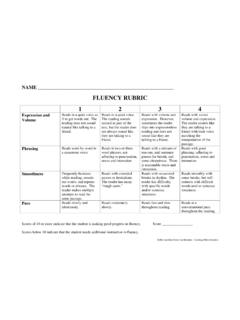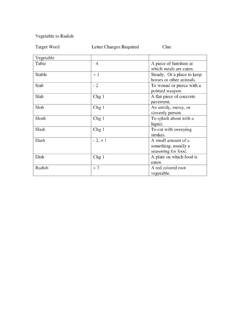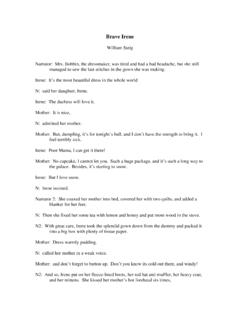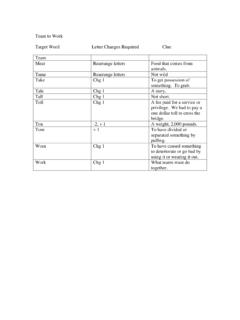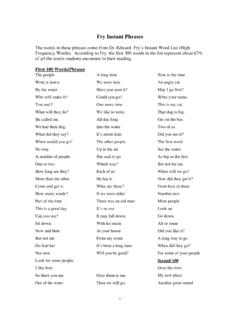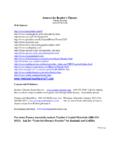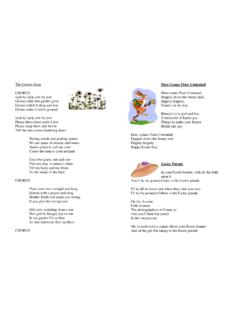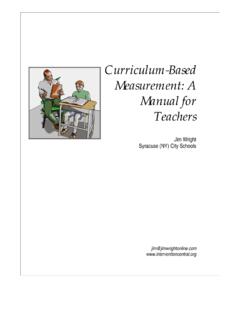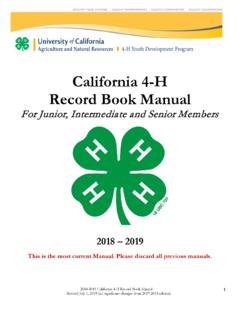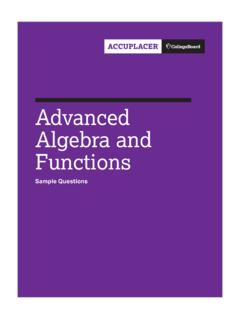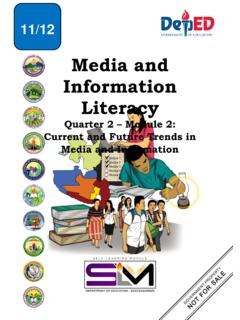Transcription of From Phonics to Fluency - timrasinski.com
1 Is proud to sponsor Dr. Timothy Rasinski From Phonics to Fluency : Effective and Engaging Instruction to Two Critical Areas of the Reading Curriculum Visit us in our booth! #2013 Teacher Created Materials 800-858-7339 You can download a copy of today s presentation handout at: Where you will also find: Links to Dr. Rasinski s published research Calendar of speaking engagements Online store where you can purchase his authored materials Announcing TCM Podcasts New Teacher Created Materials podcasts are a great way for you to stay up-to-date on educational topics.
2 Each episode will inspire you and provide useful information you can take into your classroom. The first three episodes will feature Dr. Timothy Rasinski! Episode 1- Fluency 101: Accuracy, Automaticity, and Expression Episode 2- Practice, Practice, Practice Episode 3- Making and Writing Words & Building Vocabulary Free! Subscribe to our feed at can listen now, or download for later! Effective Teaching of Reading: From Phonics to Fluency Timothy Rasinski Kent State University 402 White Hall Kent, OH 44242 330-672-0649, The Bridge from Phonics to Comprehension: Three Components of Fluency 1.
3 Accuracy in word recognition (word decoding). Approximately 95% word recognition accuracy is considered adequate for instructional level reading. 2. Automaticity in word recognition. Readers not only are accurate in word recognition, they are effortless or automatic in recognizing the words they encounter. The significance of achieving automaticity is that readers can devote their limited cognitive resources to the important task of comprehending the text. Automaticity is most often assessed by determining a reader s reading rate on a grade level passage in words correct per minute.
4 Since rate increases as readers mature, no one rate is considered appropriate. You will need to check students rate against the table of grade level norms. 3. Interpretive and meaningful reading. Readers use their new-found cognitive energy to interpret the passage they are reading. In oral reading this is done through an expressive and appropriately phrased rendering of a written passage at an appropriately fluent speed. It is assumed that this type of interpretive reading is also reflected in silent reading. Interpretive and meaningful reading is best measured through a qualitative rubric in which the teacher listens to a reader read grade level material and rates the reading according to descriptions provided in the rubric.
5 Readers who fall in the lower half of most are normally considered less than minimally adequate or proficient in Fluency . Components of Effective Fluency Instruction Fluency is the ability to read accurately, quickly, expressively, with good phrasing, AND with good comprehension. A recent study sponsored by the Department of Education found that fourth grade students oral reading Fluency is a strong predictor of silent reading comprehension. Moreover, the same study found that nearly half of the fourth graders studied had not achieved even a minimally acceptable level of reading Fluency .
6 Fortunately, a solid body of evidence suggests that Fluency can be taught and that effective instruction in Fluency leads to overall improvements in reading. Accuracy in Word Recognition Model Fluent Expressive Oral Reading for Students Repeated (Practiced) Reading of Authentic Texts o Performance Poetry, Scripts (Readers Theater), etc. Assisted (Scaffolded) Reading Focus on Phrased Reading Be Sensitive to Text Difficulty. Create Synergistic Instructional Routine For more on Fluency , see the chapter on Fluency from the Report of the National Reading Panel.
7 See also, Technical Report 2-008 from the Center for the Improvement of Early Reading Achievement ( ).. Fluency Accuracy and Automaticity: Assessment and Norms ACCURACY: Calculation: Total number of words read correct divided by Total words read (correct or corrected + uncorrected errors). Example: 137 words read correct / 145 total words read (137 correct + 8 uncorrected errors) = correct. Interpretation: 99% Correct: Independent Level Reading 95% Correct: Instructional Level Reading 90% Correct: Frustration Level Reading AUTOMATICITY.
8 Grade Fall Winter Spring 1 5 25 50-60 wcpm* 2 53 78 84-94 3 79 93 104-114 4 99 112 98-118 5 105 118 118-128 6 115 132 135-145 7 147 158 157-167 8 156 167 166-171 * words correct per minute Procedure.
9 Ask the student to read orally for one minute from grade-level curriculum material. Ask him to read in his normal manner, not overly fast or slow. Administer reading probes at least three times per year. Scoring of wcpm: Count the number of words read correctly in one minute (Include errors corrected) Analysis and Interpretation: Students reading significantly below the stated norms (20% or more below norms) are at risk in reading decoding and/or Fluency , and should be considered for further assessment and diagnosis. Adapted from: Hasbrouck, J. E. & Tindal, G. (1992).
10 Curriculum-based oral reading Fluency forms for students in Grades 2 through 5. Teaching Exceptional Children, (Spring), 41-44. and Howe, K. B. & Shinn, M. M. (2001). Standard reading assessment passages (RAPS) for use in general outcome measurements: A manual describing development and technical features. Eden Prairie, MN: Edformations. NAEP Oral Reading Fluency Scale 4 Reads primarily in larger, meaningful phrase groups. Although some regressions, repetitions, and deviations from the text may be present, these do not appear to detract from the overall structure of the story.
